
What is SOS Survival Operating System® Manual Therapy?
SOS Survival Operating System® therapy is based off the philosophy that each human being and land animal is born in survival and delaying death.
The human body is a walking miracle. The body has the potential to correct dysfunctions when the brain is able to feel the dysfunctions and the mind is aware of costly choices and actions. SOS Survival Operating System® therapy down-regulates ‘survival mode’ using two methods; one method is a hands on manual therapy for the body, and the second is information for the mind to understand cause and effect.
The manual techniques stimulate the brain to become aware of the body’s position in gravity. This awareness allows the blood flow to change and down-regulate the survival operating system. When gentle hands on therapy is applied and accepted by the brain, the blood and temperature changes in the arms and legs (the arms and legs are where the blood was due to survival mode). When the blood is allowed to return to the organ system for cleaning and replenishing it is drained from the fight/flight/protective movement system, the arms and the legs.
To keep the body in this down-regulated mode, information about what is happening and why it is happening is needed for the individuals mind. SOS Survival Operating System® shares objective information on various topics to allow the individual to make the best choices for their individual situation. SOS Survival Operating System® has a mentality that offers the client to learn how to fish and be independent, rather than supplying fish and keeping them dependent.
—>Schedule Your 1st Treatment Session & Receive 30 Complimentary Minutes<—
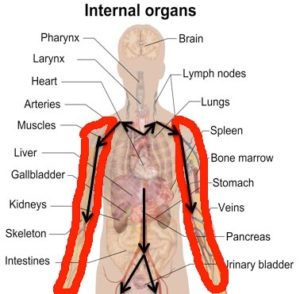
Fig. 1
Fig. 1 – In stress or survival, adrenal hormones are shunting blood primarily into the extremity to the skeletal muscles. In the survival position blood flow to the organs is drastically decreased, compromising sufficient clearance of accumulated inflammation (i.e. pot-belly, swelling, blood pooling, edema) The arms, legs and spine will be hot due to blood volume and pooling.
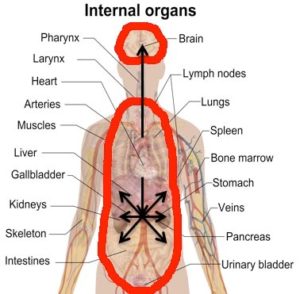
Fig. 2
Fig. 2 – Down-regulating the hormonal response allows blood flow to the organs (smooth muscle) for digestion and detoxification. This also removes volumetric pressure from the extremities, improving venous return, allowing waste and inflammation clearance from the extremity/skeletal muscles. The arms and legs will be chilled to cold and the organ system/core will be warm and relaxed.
Image modified from: http://commons.wikimedia.org/wiki/File:Internal_organs.png
SOS Survival Operating System® is a mind with body approach that respects the value of each point of view to help the mind and body be one. The awareness education and hands-on therapy is based on the SOS philosophy for the ‘how’ and ‘why’ concept. The physics addresses ‘why’ and economics addresses ‘how’ regarding the body’s condition/state. This fundamental understanding allows for respect that there is an extended aspect of the sympathetic nervous system termed ‘the survival operating system.’ When the body is perpetually and chronically stressed the survival operating system is the dominant controller.
In a position of stress created by oxygen debt the body is creating acidity. If prolonged the body enters a state of survival. This state disallows the body to adequately bring blood back to the organ system for sufficient clearance of waste (thus waste/debt creation is greater than clearance). In this state blood flow is dominant in the periphery (movement system) for a fight or flight response and to strip the body’s resources. Due to the fight or flight hormones released from internal and/or external threat (real or perceived), the body is stuck ‘on’ in survival mode ready for action, in a hyper, compressed, and contracted posture and mentality. This is automatic, reactive, and irrational-instinctual survival behavior in the body and mind.
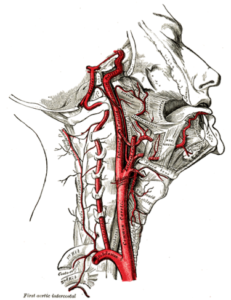
Fig. 3
Fig. 3 – Blood flow to the brain is via the vertebral and carotid arteries. SOS techniques decrease resistance to these blood vessels allowing clearance of inflammation. Image Source: Gray’s Anatomy
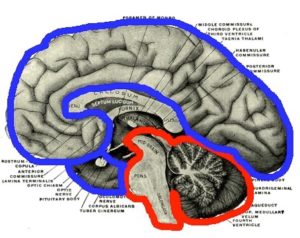
Fig. 4
Fig. 4 – Area in red is the “reptilian brain” comprised of the medulla, pons and cerebellum. In a position of survival blood flow is primarily to this area, which operates at extremes, instinctively unconscious (aka addictions). Down-regulating stress hormones from the adrenal gland shifts blood flow in the brain (area in blue). The blue area is responsive for processing consciously. The red area is reactive, reflexive, and habitual. Image: Gray’s Anatomy
Application of ‘how,’ ‘what’ and ‘when’ are respectfully applied on an individual basis. SOS acknowledges there are common postures in human anatomy, phases in physiology and psychology, and patterns in biomechanics; but each situation is unique. SOS manual therapy uses non-invasive and gentle touch to facilitate the brain’s awareness to allow down-regulation of the hormones.
“SOS manual therapy uses non-invasive and gentle touch to facilitate the brain’s awareness to allow down-regulation of the hormones.”
The down-regulation allows blood flow to change the level of awareness of the concussed (lost proprioception/lost time-space orientation/forgotten) areas of the body. The body’s threat is to be addressed first, as it is the reason for the stress hormones and scarred state of the receptors, both of which inhibit the body’s ability to truly feel. When the body’s root and immediate threat (oxygen debt/waste/acidity) is addressed the blood is allowed to return to the organ system.
This allows relaxation within the whole body and a subsequent calming in the mind. In this down-regulated state there is less demand on the body, slowing the creation of waste. When the body is relaxed, the mind calms, allowing change in observation of environment and perception. This decreases demands and stress allowing the body to remove the residual waste from an individual’s level of oxygen debt.
SOS Survival Operating System® manual techniques address the neck to change inflammation affecting the brain’s environment. This allows clearance of toxicity/waste/debt accumulated in the brain’s environment. In a position of survival, the brain utilizes the body’s path of least resistance creating compensations on compensations in anatomical movement (breathing) and biomechanical movement. Just as the body is automatically creating compensations, the mind is consciously and subconsciously doing the same.
Once inflammation is reduced, the brain can become aware of resistant/tight (sometimes painful, sometimes numb) areas in the body to which it had forgotten or lost awareness.
Compressing space compresses time
The purpose of SOS techniques is to create space/flow/expansion where there is too much time/resistance/contraction. Wherever there is too much time/contraction/resistance, this is a break in flow also known as an injury, whether acute or chronic. When injured physically or mentally, the pathway(s) to the brain and nervous system, as well as perception become resistive. Each injured location has its own reference of time, compensations, and perception, all happening and existing while all other locations are doing the same, like a spider web of relative points all intertwined to give a macro condition.
In other words, there exists a dependently-interdependent relationship between each physical or mental injury. The result of these injuries or conditions is altered body mechanics in local and global areas throughout the kinetic chain. This leads to exponential-compounding compensations originating at the cellular level and exposed on the surface.
Free the body from its cage
Survival Operating System® manual therapy addresses the rib cage to create a new reference point for expansion, allowing greater surface area for gas exchange (Fick’s Law). Creating space allows decrease in compression, decreasing resistance and decreasing gravity force imposed on the individual body. This allows greater range of motion with less effort in the rib cage and takes tension off the spine created by contraction. This allows a change in breathing mechanics, lung surface area, and posture, all reducing work/effort in gravity. Each person has their own mental perception as well as gravity.
Techniques on the rib cage remove fixed points to allow increased lung function (diffusion) by increasing surface area via increase expansion of the ribs. With increased lung function the body’s gas exchange-ventilation is improved allowing for more efficiency in detoxification. When gas exchange is optimal, there is less work for the liquid and matter systems (respiratory acidosis/alkalosis).
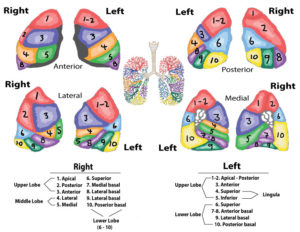
Fig. 6
Fig. 6 – Each lung has 10 sections and moves in all three dimensions simultaneously making lung inflation a quantum movement. Ideally all 10 sections will pump with equal relative volume.
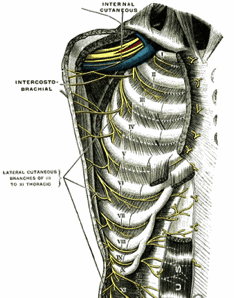
Fig. 7
Fig 7. Limitations in the lung and fixed points on the rib cage exist throughout the many layers of the torso including the superficial skeletal muscles between the ribs, diaphragm, organs, pleura, lung and/or alveoli, and nerves. Image Source: Gray’s Anatomy
SOS Survival Operating System® manual therapy applies a combination of techniques that are similar to other therapies, but differ by intention due to root philosophy. Many other modalities (aside from what is above) are used by SOS including: SOS breathing, SOS nerve release, Osteopathic techniques, sound therapy, smell therapy, massage, naturopathy, soft tissue management (fascia and muscle), joint mobilizations, and techniques for muscles and ligaments, sports rehabilitation, neuro-muscular techniques, personal exercise instruction, muscle testing, and creative life style choice. Manipulations and joint adjustments are not within the scope of Survival Operating System® manual therapy.
It is not all in your head
SOS Survival Operating System® offers awareness to identify the cost of destructive, addictive behaviours and create understanding on individual position. There is a time and space for everything. Being able to identify at an individual level what, why, how, and when to implement specific actions creates optimal results. Information is shared with the individual for the opportunity to create a more beneficial choice congruent with physics, body economics, and macro-micro fundamentals and logic.
The information is shared so the individual can understand the body’s languange of signs and symptoms. What the body needs, and how the mind perceives based on the cause and effects of the position they are in. Awareness of cause and effect limits shock, repercussions, and set backs associated with random, experimental (trial and error) behaviours. Additionally, understanding the signs and symptoms of the body allows for dietary choices based on now/the current time. When the body is in survival mode it does not care about a temporary, personal or ideological belief system but there are ways to compromise and amalgamate personal belief with physiological needs to meet the individual’s mind and body. The only thing that matters is what the body needs now/the current time.
When the body’s needs are met change is allowed
The SOS Survival Operating System® breathing exercises improve breathing capability to deliver the limiting factor of oxygen to increase removal of waste carbon (debt) from the blood and body. This meets the body’s primary need, allowing the brain (internal) and mind (external) to relax and identify areas that were previously being avoided. As the body perpetually removes debt in an ongoing process it progressively becomes more receptive to assimilating new information (ie. physical: food, mental: verbal).
The SOS breathing exercises, are given to allow one to continue their progress, be self-accountable, and increase the body’s oxygen respiration ability. The rate of change is determined by the amount of time invested in self. Progress is determined by the choices and actions of the individual, not of the therapist. Only self can heal self when aware of their true state of being. We live or die by our choices. Knowledge is power, and power is freedom.
Todd. “What Is SOS Survival Operating System® Manual Therapy.” Welcome Home, 11 June 2019, https://sos-therapy.com/chapter-1-introduction/purpose-of-treatment.